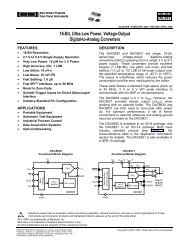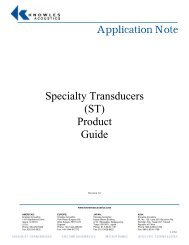AD7714* 3 V/5 V, CMOS, 500 µA Signal Conditioning ADC - dreamm
AD7714* 3 V/5 V, CMOS, 500 µA Signal Conditioning ADC - dreamm
AD7714* 3 V/5 V, CMOS, 500 µA Signal Conditioning ADC - dreamm
You also want an ePaper? Increase the reach of your titles
YUMPU automatically turns print PDFs into web optimized ePapers that Google loves.
AD7714<br />
Power-Up and Calibration<br />
On power-up, the AD7714 performs an internal reset which sets<br />
the contents of the internal registers to a known state. There<br />
are default values loaded to all registers after a power-on or<br />
reset. The default values contain nominal calibration coefficients<br />
for the calibration registers. However, to ensure correct calibration<br />
for the device a calibration routine should be performed after<br />
power-up.<br />
The power dissipation and temperature drift of the AD7714 are<br />
low and no warm-up time is required before the initial calibration<br />
is performed. However, if an external reference is being<br />
used, this reference must have stabilized before calibration is<br />
initiated. Similarly, if the clock source for the part is generated<br />
from a crystal or resonator across the MCLK pins, the start-up<br />
time for the oscillator circuit should elapse before a calibration<br />
is initiated on the part (see below).<br />
USING THE AD7714<br />
Clocking and Oscillator Circuit<br />
The AD7714 requires a master clock input, which may be an<br />
external <strong>CMOS</strong> compatible clock signal applied to the<br />
MCLK IN pin with the MCLK OUT pin left unconnected.<br />
Alternatively, a crystal or ceramic resonator of the correct frequency<br />
can be connected between MCLK IN and MCLK OUT<br />
in which case the clock circuit will function as an oscillator,<br />
providing the clock source for the part. The input sampling<br />
frequency, the modulator sampling frequency, the –3 dB frequency,<br />
output update rate and calibration time are all directly<br />
related to the master clock frequency, f CLK IN . Reducing the<br />
master clock frequency by a factor of 2 will halve the above frequencies<br />
and update rate and double the calibration time. The<br />
current drawn from the DV DD power supply is also directly<br />
related to f CLK IN . Reducing f CLK IN by a factor of 2 will halve<br />
the DV DD current but will not affect the current drawn from the<br />
AV DD power supply.<br />
Using the part with a crystal or ceramic resonator between the<br />
MCLK IN and MCLK OUT pins generally causes more current<br />
to be drawn from DV DD than when the part is clocked from<br />
a driven clock signal at the MCLK IN pin. This is because the<br />
on-chip oscillator circuit is active in the case of the crystal or<br />
ceramic resonator. Therefore, the lowest possible current on<br />
the AD7714 is achieved with an externally applied clock at the<br />
MCLK IN pin with MCLK OUT unconnected and unloaded.<br />
The amount of additional current taken by the oscillator<br />
depends on a number of factors—first, the larger the value of capacitor<br />
placed on the MCLK IN and MCLK OUT pins, then<br />
the larger the DV DD current consumption on the AD7714. Care<br />
should be taken not to exceed the capacitor values recommended<br />
by the crystal and ceramic resonator manufacturers to<br />
avoid consuming unnecessary DV DD current. Typical values recommended<br />
by crystal or ceramic resonator manufacturers are in<br />
the range of 30 pF to 50 pF and if the capacitor values on<br />
MCLK IN and MCLK OUT are kept in this range they will not<br />
result in any excessive DV DD current. Another factor that<br />
influences the DV DD current is the effective series resistance<br />
(ESR) of the crystal which appears between the MCLK IN and<br />
MCLK OUT pins of the AD7714. As a general rule, the lower<br />
the ESR value then the lower the current taken by the oscillator<br />
circuit.<br />
When operating with a clock frequency of 2.4576 MHz, there is<br />
no appreciable difference in the DV DD current between an<br />
externally applied clock and a crystal resonator when operating<br />
with a DV DD of +3 V. With DV DD = +5 V and f CLK IN =<br />
2.4576 MHz, the typical DV DD current increases by 50 µA for a<br />
crystal/resonator supplied clock versus an externally applied<br />
clock. The ESR values for crystals and resonators at this frequency<br />
tend to be low and as a result there tends to be little difference<br />
between different crystal and resonator types.<br />
When operating with a clock frequency of 1 MHz, the ESR<br />
value for different crystal types varies significantly. As a result,<br />
the DV DD current drain varies across crystal types. When using<br />
a crystal with an ESR of 700 Ω or when using a ceramic resonator,<br />
the increase in the typical DV DD current over an externallyapplied<br />
clock is 50 µA with DV DD = +3 V and 175 µA with<br />
DV DD = +5 V. When using a crystal with an ESR of 3 kΩ, the<br />
increase in the typical DV DD current over an externally applied<br />
clock is again 50 µA with DV DD = +3 V but 300 µA with DV DD<br />
= +5 V.<br />
The on-chip oscillator circuit also has a start-up time associated<br />
with it before it is oscillating at its correct frequency and correct<br />
voltage levels. The typical start up time for the circuit is 10 ms<br />
with a DV DD of +5 V and 15 ms with a DV DD of +3 V. At 3 V<br />
supplies, depending on the loading capacitances on the MCLK<br />
pins, a 1 MΩ feedback resistor may be required across the crystal<br />
or resonator in order to keep the start up times around the<br />
15 ms duration.<br />
The AD7714’s master clock appears on the MCLK OUT pin of<br />
the device. The maximum recommended load on this pin is one<br />
<strong>CMOS</strong> load. When using a crystal or ceramic resonator to generate<br />
the AD7714’s clock, it may be desirable to then use this<br />
clock as the clock source for the system. In this case, it is recommended<br />
that the MCLK OUT signal is buffered with a <strong>CMOS</strong><br />
buffer before being applied to the rest of the circuit.<br />
System Synchronization<br />
The SYNC input (or FSYNC bit) allows the user to reset the<br />
modulator and digital filter without affecting any of the setup<br />
conditions on the part. This allows the user to start gathering<br />
samples of the analog input from a known point in time, i.e., the<br />
rising edge of SYNC or when a 1 is written to FSYNC.<br />
The SYNC input can also be used to allow two other functions.<br />
If multiple AD7714s are operated from a common master clock,<br />
they can be synchronized to update their output registers simultaneously.<br />
A falling edge on the SYNC input (or a 1 written to<br />
the FSYNC bit of the Mode Register) resets the digital filter and<br />
analog modulator and places the AD7714 into a consistent,<br />
known state. While the SYNC input is low (or FSYNC high),<br />
the AD7714 will be maintained in this state. On the rising edge<br />
of SYNC (or when a 0 is written to the FSYNC bit), the modulator<br />
and filter are taken out of this reset state and on the next<br />
clock edge the part starts to gather input samples again. In a system<br />
using multiple AD7714s, a common signal to their SYNC<br />
inputs will synchronize their operation. This would normally be<br />
done after each AD7714 has performed its own calibration or<br />
has had calibration coefficients loaded to it. The output updates<br />
will then be synchronized with the maximum possible difference<br />
between the output updates of the individual AD7714s being<br />
one MCLK IN cycle.<br />
–24–<br />
REV. B















